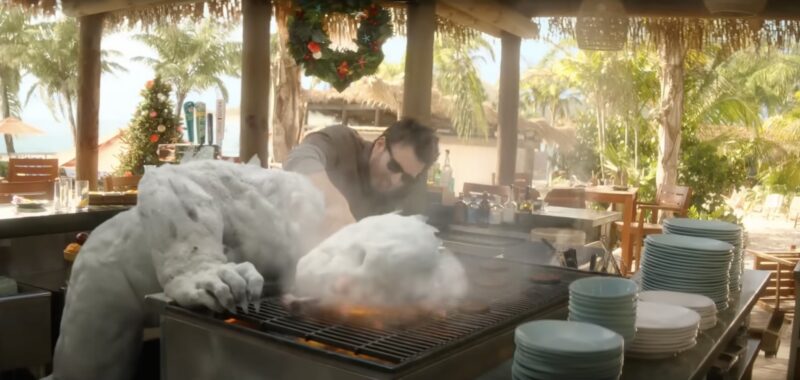I wasn’t planning to review Red One. I was going to ignore it. but then Dwayne Johnson went and said this, out loud, in public:
“I watch Oppenheimer. It was amazing, but I was thinking: ‘Holy shit. Red One on this screen and with this technology could be game over.’ I remember texting [director Jake Kasdan] a picture of my bare chest and a picture of the screen and we realized how cool [Imax] would be.”
And I’m sorry, but my boy Bobby Oppenheimer did not build a bomb as big as a damn bus, and my boy Christopher Nolan did not make an epic deconstruction of a Great Man Biopic, and my eternal beloved Cillian Murphy did not turn in one of the greatest performances of the century so far, to be mentioned in the same fucking breath with a two-hour-and-two-minute long slab of joyless Gowanus Canal-water-looking content that essentially tells a story that The Tick cartoon told in the ’90s, in 23 minutes, better.
OK, plot: A cynical ne’er-do-well black-hat (hahaha) hacker mercenary named (heavy sigh) Jack O’Malley takes a job that crashes the North Pole security dome, thus allowing Santa, in whom he does not believe, to be kidnapped. Then he has to open his heart to whimsy, recant his Santatheism, and believe in the Spirit of Christmas in order to save—wait, that never actually happens. He’s whisked away to the North Pole, meets some mythological creatures and a sentient polar bear, learns that he’s been on the Naughty List—which is a real thing—for most of his life, and accepts this new reality almost instantaneously. He helps save Santa because a secret government agency pays him a shitload of money to do so.
OK, let’s try this one: the head of Santa’s security detail, (heavier sigh) Enforcement Logistics and Fortification (E.L.F., you see), an inhuman creature of indeterminate strength named Callum Drift, is having a crisis of faith. It’s only by risking his own life to save Santa that he rekindles his belief in the Spirit of Christmas, and saves—hmm, hang on, that kind of happens, but the rekindling of faith part gets jammed into the last five minutes of the movie and doesn’t really land? And happens after he’s already helped save Santa with his giant, indeterminately powerful fists.
All right, how about: An extremely powerful magical nemesis of Santa’s attempts to hijack Christmas (with the help of Santa’s estranged brother) in order to punish the Naughty and terrify humanity into being Nice, but Santa’s kindness and compassion eventually win the day—oh, actually never mind. That does sort of happen, but we never really know why the old nemesis is doing this, we never know why she’s doing it right now, or get a sense of how terrifying the plot actually is. Santa and his brother reconcile over like two lines of dialogue after the Big End-Of-Movie Battle, and it’s Cal, Jack, and the brother who defeat the nemesis while Santa’s unconscious.
OK, what about: the whole film is a meditation on the very concept of Nice and Naughty, the eternal struggle between humanity’s better and baser natures. The filmmakers use Christmas as a unique and festive platform to ask Big Questions about free will, faith, gift-giving, and the state of the world in 2024.
Hahahahaha no.
No, there are repeated interminable conversations about Nice-ness and Naughty-ness that wheeze along like an asthmatic reindeer pulling an overburdened sleigh, but there’s never any sense that Santa’s given this shit real thought, and the act that supposedly moves Jack into Nice-ness after lifetime on the Naughty List is tiny, arguably self-serving—and the magical nemesis still punishes him anyway. (And the idea that maybe people who don’t believe in Santa shouldn’t be on his list in the first place is never really broached.)
Oh but perhaps you’re saying “Let people enjoy things”? That it’s a film for children?
Is it?
It’s a slog of blurry, unnecessarily brutal fight scenes, treacly speeches about choice, and characters saying “Holy Shit!” every time a new mythological creature shows up. Paddington is for children, but I could always tell what was happening in that movie, and I cared about the characters, and when there were speeches they sounded like things people might actually say to each other, and no one cursed for no reason. (And yeah, believe me, I’m also surprised at my annoyance at the cursing, but I write my reviews and essays with an at-least-9th-grade audience in mind. I don’t think eight-year-olds need to watch scenes where characters threaten to slap each other to death while another character says “shit” every ten minutes to tell the audience they should be having an emotional reaction to what they’re seeing.) And also children deserve better. We all deserve better, but children especially. It’s not their fault they were born after the MCU and the need for constant streaming “content” turned every movie and TV show into washed out grey sludge with no stakes and terrible writing.
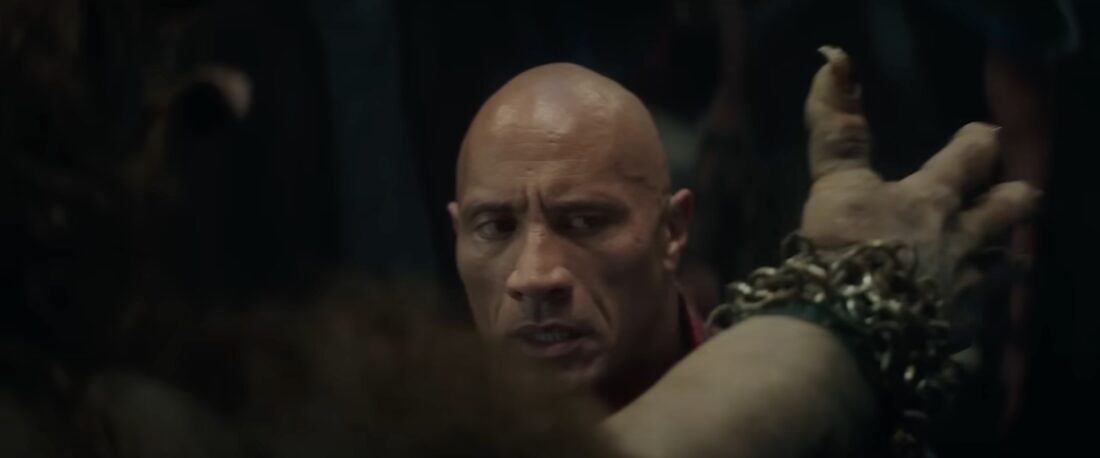
If for some reason you’re concerned about spoilers—don’t be, you’ve seen everything in this movie many times before—you should board your sleigh and jingle hop off to a different movie review now.
But hang on, maybe I should lay my bonafides on the table. To paraphrase Crow T. Robot, I absolutely believe that a good action sequence belongs in Christmas. Die Hard is one of my favorite movies of all time, Christmas or no Christmas. I love Lethal Weapon (aside from the slurs), I love Iron Man 3 and Kiss Kiss Bang Bang, and, ok, seriously, Shane Black might be my own personal Santa. I love Dark Weird Christmas. Less Than Zero is a Christmas movie. So is Carol. So is Eyes Wide Shut. So is Trading Places. So is William Burrough’s A Junky’s Christmas. So is In Bruges. So, to my utter delight, is Small Things Like These. I love that the internet seems to discover a New Terrifying European Christmas tradition each year. I love Deconstruction Christmas because irony is the air that I breathe, and I love the gap between the hyper-sincerity of Christmas and something like Invader Zim or The Tick or South Park or AD/BC or Gremlins or Batman Returns or, or, or. I love Poignant Christmas, “River”, The Boondocks, The Snowman, The Apartment, the “Seven Fishes” episode of The Bear, 3/4s of Sufjan Stevens’ Christmas catalogue.
So please, please understand, this movie should have been my mulled cranberry jam.
Our film opens on an overstuffed suburban house (presumably just down the road from the McCallister’s) where a comically huge family has gathered for the holiday. But one boy, a Non-Believer, lifts his uncle’s keyring to unlock the closet where the toys are hidden and convince his cousins there’s no Santa Claus. The uncle catches them, explains that all Jack, because of course this is Young Jack, has found is the gifts the family bought for the kids—Santa is still coming with more stuff, never fear. Oh and also Jack’s dad is AWOL, his mother isn’t mentioned or seen, our Jack is a troubled lad, all right.
As character introductions for a Christmas film go, it’s not terrible, just predictable. But there’s plenty to work with here! And given that the film comes down to a debate over the efficacy of Nice and Naughty lists, the idea that Jack will later be placed on the Naughty List by an objectively real Santa, and have to grapple with the consequences of that, is a great conflict to start with.
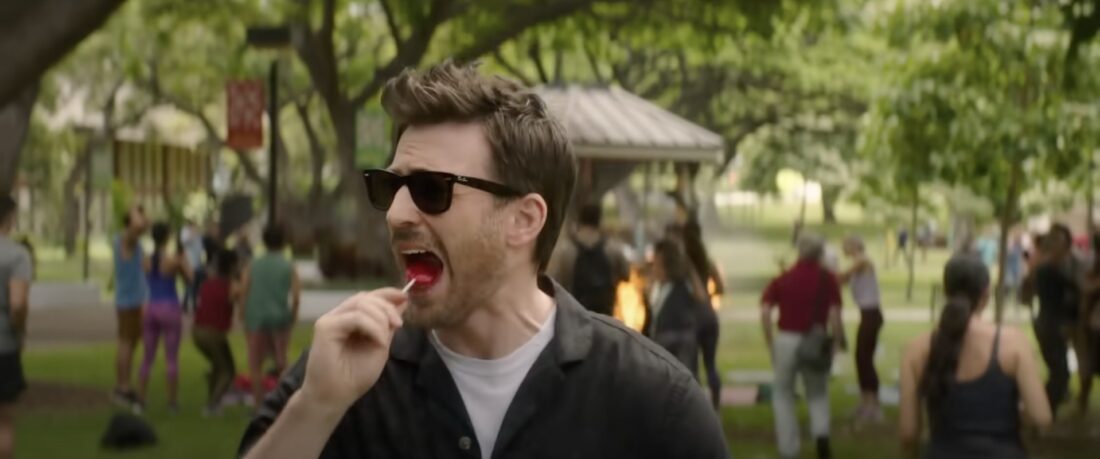
Unfortunately we get a second introduction, to Adult Jack, where he orchestrates an elaborate heist that doesn’t really work or make any sense, but that’s meant to show us how little he cares about society or other people, and then to really drive the point home he literally steals candy from a baby. Remember when Chris Evans gave a hilarious performance in Knives Out, and people like me were ecstatic because he was throwing off the metaphorical cape of Captain America and having fun playing a total asshole? This is like that, except it’s exhausting and makes me sad.
The heist also shows him being good at literally everything he would need to be good at to pull it off, and later he turns out to be as good at movie fighting as someone who played a superhero would be. Except, again, he’s playing a computer hacker. Did I mention yet that at one point, to really drive home how much he doesn’t care about anything, man, the movie’s writers have him wake up in a bathtub with a slice of pizza on his chest? Placed at a perfect jaunty angle on his otherwise clean shirt, to try to convince us that he cares so little about anything, man, that he fell asleep eating pizza in a bathtub even though his living room is two feet away and there is no grease on the shirt?
Full disclosure: I mention this because I, too, once had a character wake up in a bathtub to indicate that she didn’t care about anything, man. But I wrote that scene when I WAS NINETEEN YEARS OLD AND I WAS NOT CHARGING $25 PER IMAX TICKET FOR PEOPLE TO SEE IT.
Sorry. Let me take a breath. I could forgive all of this, honestly, hand to Santa, if only the whole thing where Jack rejected Christmas and all of its works paid off. But it doesn’t. Once he’s brought to the North Pole, and told Santa is a) real and b) in trouble, he doesn’t wrestle with his concept of reality. He doesn’t have a breakdown or even go through a comic montage of refusing to believe the evidence of his eyes, he just accepts that his entire worldview is wrong and mythological creatures are real in the space of like two conversations with The Rock. Interminable hours later, when he finally meets Santa, it’s completely anticlimactic because it happens during the Big End-Of-Movie Battle, and, oh yeah, Santa’s unconscious.
Then there’s Dwayne Johnson’s character, who’s named Callum Drift for some reason. We never learn what he is. And look, I don’t mean to sound species-ist, but in a movie about mythological holiday people we shouldn’t we learn what Cal’s background is, why he works for Santa, why he’s hundreds of years old and super strong, how strong he actually is? Because there are a couple points in the movie where he’s explicitly threatened with death (Merry Christmas, everybody!) and I never knew if I was supposed to be worried because as far as I could tell he was invulnerable! How can I invest in this dude when all I know about him is that he wants to quit being Santa’s head of security because he “can’t see it anymore”—but even this is just told to us, directly, over multiple conversations, and we aren’t shown what that phrase means until the last five minutes of the movie.
All right, sorry again, let me try to get this in hand. Does Red One want to be edgy Deconstruction Christmas? The North Pole is not a quaint Northern European village, but a bustling metropolis full of towering glass buildings that are just begging for Tom Cruise to free climb them in a better movie. Oh and don’t worry, all those people bustling around handily disappear when the Big End-Of-Movie Battle happens, I wouldn’t want you to worry, or have any sort of emotional investment in what happens in this film.
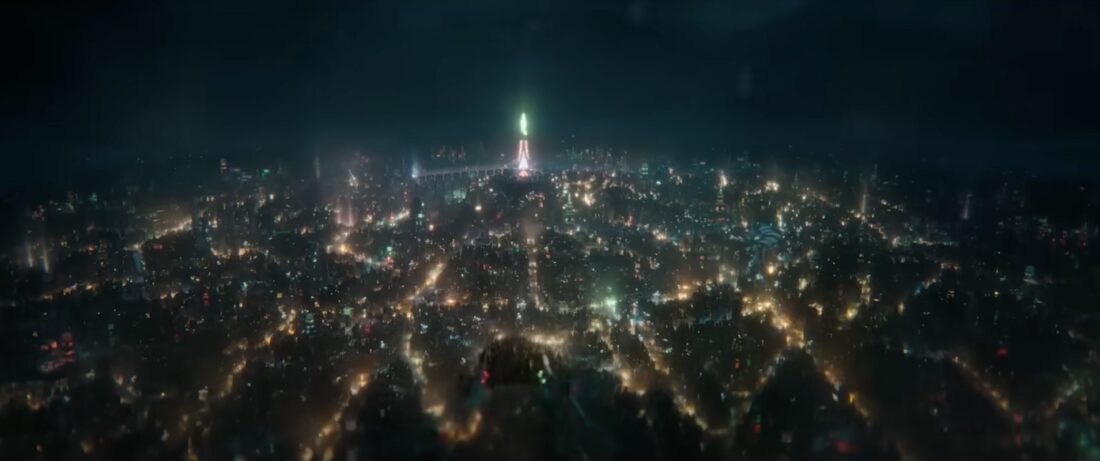
As I mentioned at the start, Santa isn’t assisted by elves but by E.L.F., a giant bureaucracy of non-humans with jobs ranging from “Ribbons” to “Security”. That’s pretty edgy, right? Well, we never get to see any of the E.L.F. inner workings after the introduction scene, so don’t get too excited. There’s also M.O.R.A. the (heaviest sigh) Mythological Oversight and Restoration Authority, an organization that manages mythological creatures just like in Hellboy or Cabin in the Woods, except not as good, because you only get to see one mythological figure. I try not to harp about film budgets cause it’s not like it’s MY money, but for over 200 million dollars maybe they could have at least given us more mythological folks than The Nightmare Before Christmas did back in 1993?
Oh, there’s an Embiggening Ray (I’m calling it that, I can’t remember if they ever say the name of the thing) that you can use to make things BIG? Cool! Well kind of cool—the Rock uses it repeatedly during fights to shrink and grow himself, but it’s never funny or interesting because the green screen choreography is too boring for it to make a difference. They use it to make a car big—you saw that scene in the trailer right? Well, you will believe they can make a second car big in exactly the same way so it’s boring now. And then later they make some Rock ‘Em Sock ‘Em Robots big, but they don’t look real at all, and they’re destroyed within seconds, so here again, not much of a pay off.
OK, so maybe the makers of Red One are going for Dark Weird Euro Christmas?
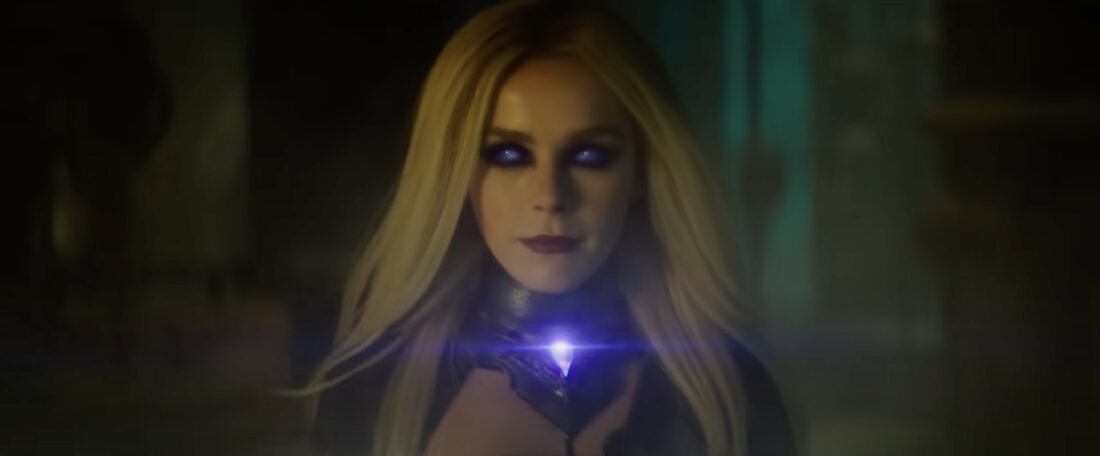
Well, Grýla is here… um, occasionally. In our world, Grýla is a giant Icelandic Ogress who wanders around demanding tribute from people—especially tribute in the form of naughty children to boil alive and eat. In Red One, she’s Santa’s ancient magical enemy who I mentioned up top, and boy is she underused, and then used badly when she’s onscreen. They introduce her Lore incredibly quickly in a conversation between Cal, Jack, and Nick Kroll’s character, not in a flashback to anything she did, or a storybook, or an actual Icelandic person talking about the havoc she wreaked. When we see her, all she does is yell at people in that I AM A PISSED OFF GIRLBOSS voice that women use in action movies, until its time for her to become her final, blurry, CGI form for the badly lit Big End-Of-Movie Battle, which happens at night, in the dark.
(…Gaslight, Gatekeep, Grýlaboss? Is that anything?)
Oh and Grýla’s thirteen sons, the Yule Lads, are here, but they do nothing. What the hell kind of a Christmas movie wastes not just one, but all thirteen Yule Lads.
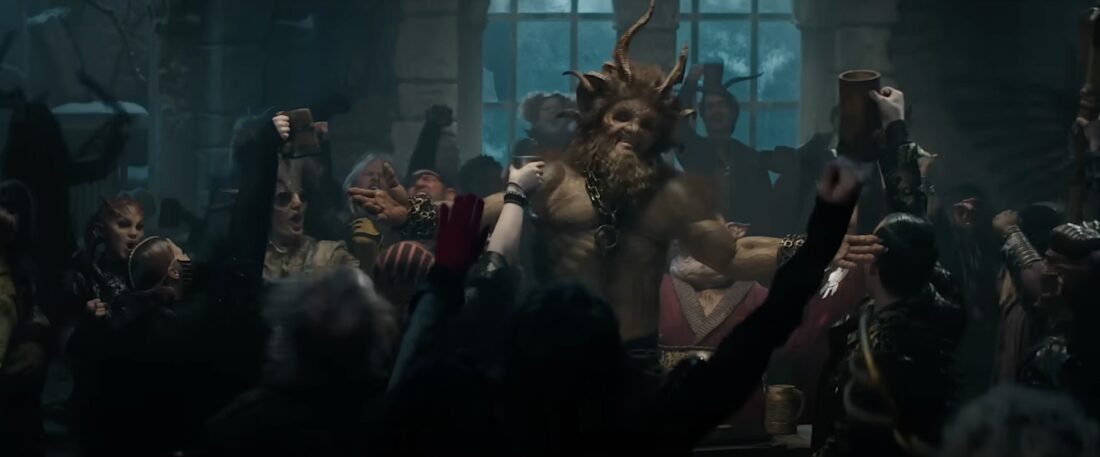
Krampus is Santa’s brother, and Grýla’s ex, and it’s all predictable unresolved anger and grievance, with the only surprising thing being that this Krampus is nowhere near as scary as the cartoon version that appeared on The Venture Brothers. Cal and Jack crash his Krampusnacht party, which is a teeming room of ogres and trolls and hot goth girls who cheer and love violence, because that’s unique and interesting in 2024. This wouldn’t be as bad, except that this is the pivotal scene where Jack makes a choice that gets him off the Naughty List—but the choice comes out of nowhere, and is overwhelmed by the bland, inconsequential violence of the party. When Cal inevitably challenges Krampus, since we don’t know what Cal’s strengths and weaknesses are, there’s no real sense of stakes, just the same endless plateau of meaningless violence as in every other fight scene.
You know how the good thing about A Very Shane Black Christmas is the juxtaposition of violence and Christmassy stuff? Yeah, there’s no juxtaposition here, because even when Jack and Cal are walking through a Christkindlmarkt in Germany it never feels like Christmas, it feels like a backlot somewhere outside Atlanta. OK, perhaps that’s too subjective, so let me also say: you know how the great thing about Die Hard is the juxtaposition between a) Christmas!, b) the high-end slick, Euro-violence of Hans Gruber and his men, and c) the street-level, sarcastic, barefoot, terrified, ordinary guy-ness of John McClane? Chris Evans’ fully human character should die at least twenty different times over the course of the film, but just, doesn’t. He is trapped in terrifying situations that he is utterly unprepared for, he is literally thrown through walls by magical evil snowman, but somehow he can just jump back up and shake it off, and toss off a quip.
Maybe that’s the true meaning of Christmas?
The climactic fight (of course it’s a fight, and not anything more interesting) happens at night, in the dark, and is once again the blurry, sludgy CGI action that is the true legacy of the MCU. The villain is seemingly defeated and rises again. A character that seemed like an antagonist suddenly switches sides. Normal human hacker Jack is given Batman-v-Bane level injuries, and just keeps quippin’.
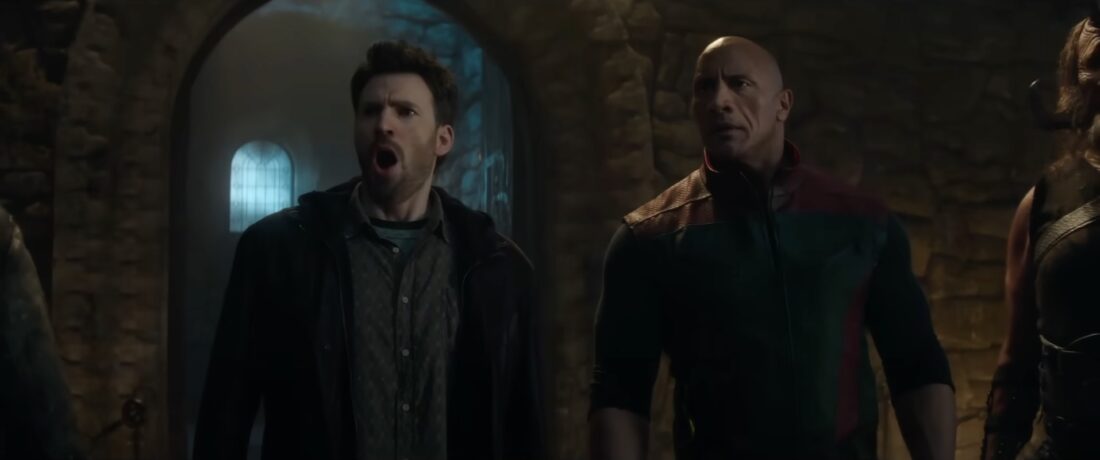
All right, fine, Leah, you hated the movie. But as you keep complaining that this film doesn’t pay any of its ideas off, are you planning to come back around to that stuff about Oppenheimer from the opening paragraph? I am! Right now in fact! You see, Dwayne Johnson chose to call Oppenheimer out specifically as a touchstone for his movie. And on the one hand, I get it, you’re trying to encourage people to see the thing you spent time on, and naturally you name check a project that was successful. I get it, I do, but here’s the thing: a cursory glance through the way the two movies approach their stories shows just how much more seriously Oppenheimer took the idea of crafting a film.
Most of the important conversations and exposition (there’s enough exposition to fill Santa’s infinite bag) take place in a car. Cal and Jack either stare stoically ahead, or smirk, or attempt to make eye contact when they ought to be watching the road. Cal lectures Jack about the importance of making choices, or Jack grudgingly or smirkingly admits to being Naughty. A pivotal conversation between Cal and Santa happens in Santa’s gym, with the joke being, I think, that Dwayne Johnson is spotting Santa Claus. But it’s just a normal-looking bland room with some weights in it. It could be a gym in any movie. The lighting is ordinary overhead lighting.

In Oppenheimer, a few of the most important conversations take place on trains. These are shot with the characters facing each other, listening to each other, responding to each other, and all the exposition is intercut with scenes that either deepen what the characters are saying, or act as counterpoints to the lies they’re telling each other. One pivotal conversation takes place between Oppenheimer and Jean Tatlock while they’re both sitting naked in a hotel room immediately after sex. Another takes place between Oppenheimer and his wife Kitty while they’re on horseback, galloping over a New Mexican mesa. Hell, come to think of it, Oppenheimer says his most famous catchphrase during sex with Jean.
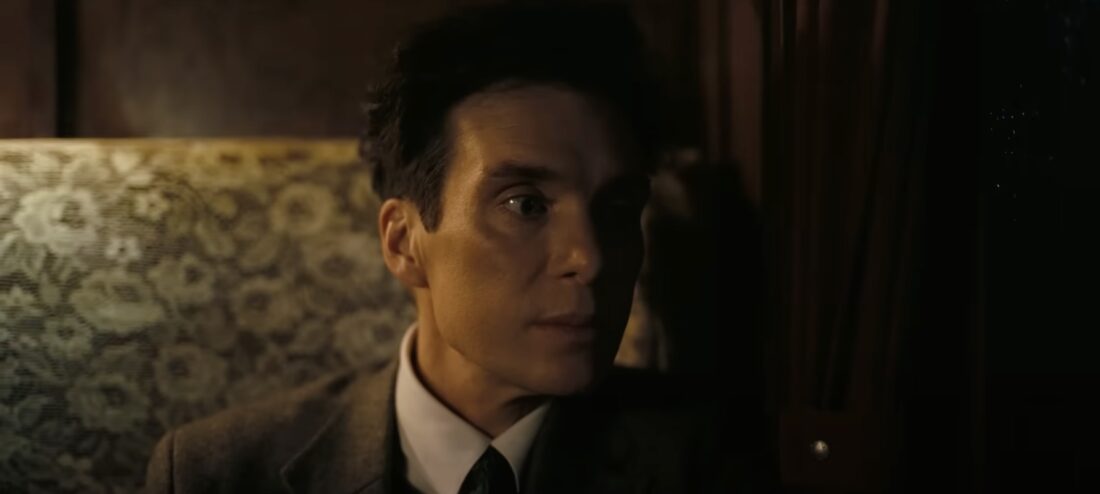
Now I’m not saying that we needed Cal and Santa to hook up while they talked about Nice-ness and Naughty-ness and the choices people make, but I am saying that this conversation could have happened, I don’t know, under a Christmas tree? Or in front of a conveyor belt of ornaments? Or, you know what, you want to go for the gag that Santa’s a gym rat because delivering the toys is incredibly taxing—fabulous! Then make the gym Christmassy! Gingerbread Gym! Candy Cane Gains! Anything to underscore what they’re saying, or at least to make Red One feel like a Christmas movie.
In Oppenheimer the worldbuilding is very clear. We see that Robert has the intelligence and privilege to hop all over Europe as he pursues a rarefied education. We see that he chooses the company of intellectuals and communists. We see him attend classes and cocktail parties, we see him attract intelligent, gorgeous women, we see him gather devoted students. We also see that he’s depressive, that he had a breakdown in college, that he is attracted to communism but won’t commit, but also refuses to believe that this dalliance might ever mess up his future under a conservative U.S. government. He juggles women. He makes truly horrifying choices, that then lead to terrible consequences not just for him, but for all of us, forever.

You know, worldbuilding. We know Oppy’s world, very early in the film. We know his friends, his lovers, his enemies, his strengths, his weaknesses. We learn all of this very quickly, so as the three-hour runtime unspools, we know all the characters were dealing with. We can watch the Q clearance hearings, and think back to his youthful nervous breakdown. We can look at Kitty, coiled like a cobra in the corner during the hearings, and think back to Jean Tatlock sobbing on a hotel floor. We can see hale and blustery Colonel Groves, largely ignored by the Q Clearance committee, and remember the power the man wielded at an earlier point in his life.
In Red One we never know what Cal is. He’s the head of security for E.L.F., he isn’t human, and he’s hundreds of years old. We don’t know what his powers are. We don’t know why he gets to wield the Embiggener, or who made it, or if anyone else has one. We never know if we should be afraid for him. We never know how he came to work for Santa, how he rose through the ranks, what he’ll do after he quits, nothing. We never see Grýla or the Yule Lads do… anything, really. We don’t get a flashback of Santa and Krampus together, we’re just told about their rift (in a car conversation, iirc) a few minutes before we need to know who Krampus is for the next scene to work. We don’t know why the reindeer love Cal especially, or if they have any other loyalties, powers beyond flight, more than basic sentience, anything. Santa is referred to by his saint’s name—Nicholas of Myra—but the fact that he’s a real, canonized-in-our-world saint, from a particular religious tradition, is not dealt with. Why is he immortal? Why is he able to deliver the presents? We see how, sure, but why? How did he and Mrs. Claus meet? Is she human? Why is there one (1) sentient polar bear? What about all the kids on earth who aren’t Christian? (And I’m not even going to mention that other Christmas figurehead.)
But even aside from all that. Red One‘s theme, as its characters remind us again and again (and again and again), is that humans have to make a choice between being Nice and being Naughty.
Which is also what Oppenheimer is about.
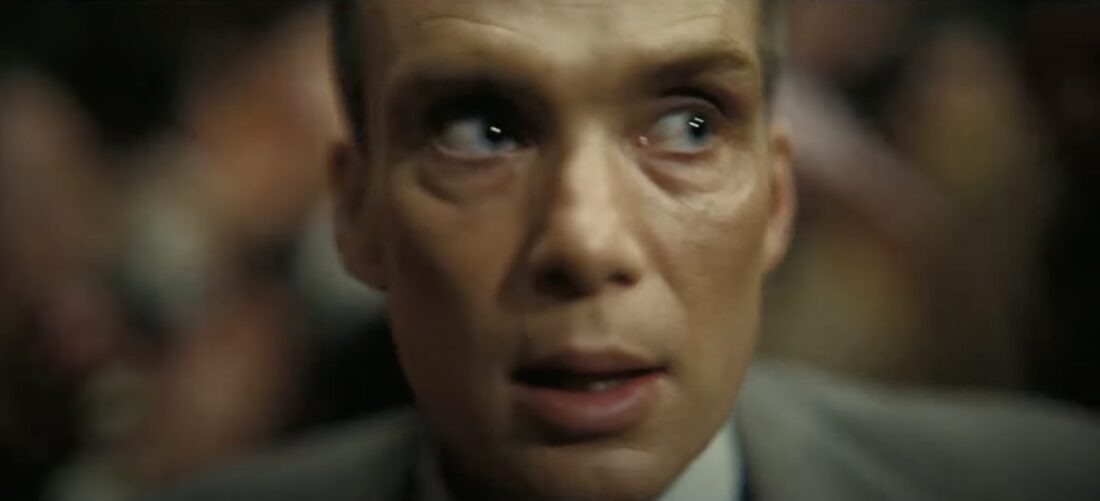
Grýla wants to punish the Naughty, no matter how tiny their crimes, to force the world to be Nice. Essentially that’s undoing free will, which I guess means that in the universe of this movie free will is real, but that’s never really discussed either. (I mention it because who knows if it’s real in our world? It might be, it might not be. But if it’s an objective reality in the world of the film, that’s a thing we should know.)
Oppenheimer is about choice. it’s about a person with great talents and knowledge, who has to make an enormous decision to use his knowledge to create something that has the power to destroy all life as we know it, or to refuse to use the knowledge for that and to campaign for others to likewise refuse.
We see that Oppy is a great organizer, blisteringly charismatic, able to talk people into almost anything. We see that there are multiple points in the project where he could have said no or stalled or obfuscated or straight up lied to keep the invention of the bomb at bay. At the point when the math tells the scientists at Los Alamos that they might set the atmosphere alight the first time they test, Oppenheimer could have backed off and said it wasn’t worth the risk, and the others would have followed. Even as the day of the Trinity test dawns, the last possible shot, the weather turns against him, but instead of throwing up his hands and throwing in the towel, he pushes to go through with it, insisting that the weather will change by the time of the test. He’s right; he knows the desert. But that’s just it: he’s the one who knows the desert. If he’d said, “Aw shucks, this weather will ruin the test, let’s call the whole thing off!” they might have. Groves would have missed the deadline that Truman had set, and maybe at that point the government would have given up the idea as a folly, given the the Nazis were already defeated, and the Japanese were running out of resources and may have given up. (I mean, maybe. Governments are gonna government.) Would it have been brutal, still? Yeah, probably—it is, after all, war. But would it have meant that all the rest of us wouldn’t have to live under the threat of nuclear armageddon, forever? Would that have been “worth it”? Has the concept of “worth it” become meaningless in the face of this much death and horror?
But we won’t ever know, because in this world he decided to run with it, and in the world of the film he decided to run with it because he was so turned on by the power of creating this bomb that he trampled over every single obstacle to get to Trinity.
Again, I only bring all of this up because Dwayne Johnson did. Oppenheimer is about choices all the way down. Robert chooses to try to poison his teacher. He chooses to juggle different relationships with women. He chooses to prioritize his work over his family, but also to abandon his wife to the work of mothering and homemaking even though she doesn’t enjoy either thing. He chooses to organize students and flirt with communism, and then chooses to abandon that flirtation to become a warmonger. He chooses to go through with the project. He chooses to advocate for arms control later, at great personal and professional cost, despite the futility of his protests.
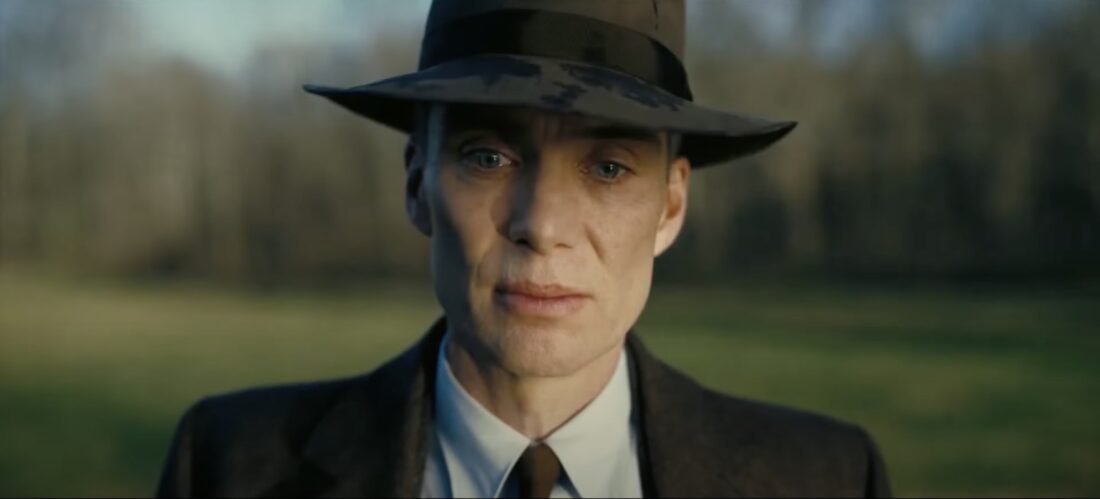
The movie, like Red One, is about action and consequence, choice and regret, free will and futility. Red One gives us a “black-hat” hacker mercenary who decides to be Nice in a split second, after a lifetime on the Naughty List, and acts like it’s the easiest thing in the world. It gives us Cal the good soldier, giving up his career because of a serious existential crisis, a real rift in how he views the world, who can also regain his old belief system in the blink of an eye, and go on like nothing ever happened. It gives us a Santa who spends the majority of the film asleep, and a Gryla who wants to punish the Naughty, without ever defining what Naughty means, or seeing that her own choice is itself Naughty.
Did J. Robert Oppenheimer do enough, in those later years, to get off humanity’s Naughty list? I don’t feel qualified to answer that, but at least Nolan takes the central question of his film seriously.

